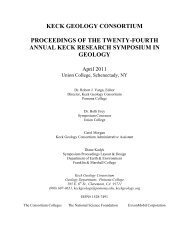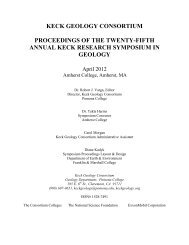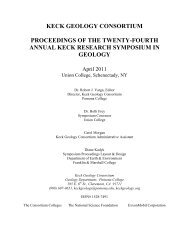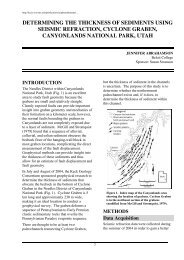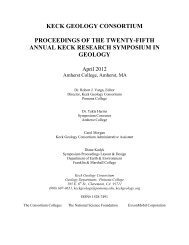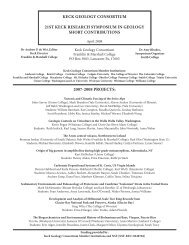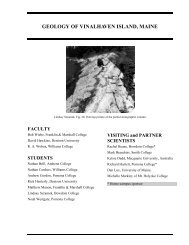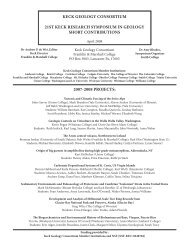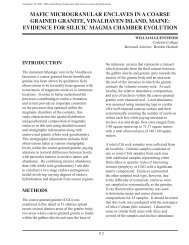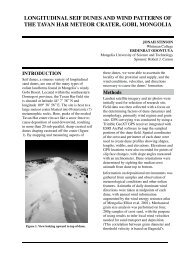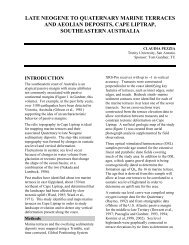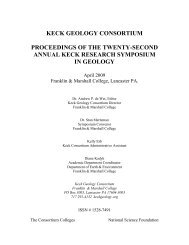geology of vinalhaven island, maine - Keck Geology Consortium
geology of vinalhaven island, maine - Keck Geology Consortium
geology of vinalhaven island, maine - Keck Geology Consortium
Create successful ePaper yourself
Turn your PDF publications into a flip-book with our unique Google optimized e-Paper software.
GEOLOGY OF VINALHAVEN ISLAND, MAINE<br />
R. A. WIEBE, Franklin & Marshall College<br />
DAVID HAWKINS, Denison University<br />
R. A. WOBUS, Williams College<br />
INTRODUCTION<br />
This project examined the <strong>geology</strong> <strong>of</strong><br />
Vinalhaven Island (Fig. 1). The plutonic rocks<br />
on Vinalhaven belong to the Coastal Maine<br />
Magmatic Province (Hogan and Sinha, 1989),<br />
and represent the roots <strong>of</strong> a Silurian bimodal<br />
volcanic system that apparently developed in<br />
an extensional tectonic setting, possibly in a<br />
back-arc environment. Three previous <strong>Keck</strong><br />
projects in Maine have studied similar systems<br />
along the Maine coast (Cadillac Mountain and<br />
Gouldsboro complexes in 1993 and 1994, and<br />
Vinalhaven in 1998) and led to the publication<br />
<strong>of</strong> several papers (Wiebe et al., 1997a, 1997b;<br />
Wiebe and Adams, 1997). The Vinalhaven<br />
plutonic complex appears to be perhaps the<br />
best exposed <strong>of</strong> these bimodal intrusions. The<br />
coastal outcrops are superb and show complex<br />
commingling and mixing relations between<br />
gabbroic, dioritic and granitic rocks near the<br />
base <strong>of</strong> the intrusion. Extensive areas <strong>of</strong> large<br />
contact-metamorphosed blocks <strong>of</strong> country<br />
rock also occur iin the lower portions <strong>of</strong> the<br />
pluton. Two varieties <strong>of</strong> granite, along with<br />
tonalite, and gabbro are widely exposed and<br />
easily sampled in coastal sections, numerous<br />
quarries, and glaciated inland exposures.<br />
To the northwest, the Vinalhaven pluton has<br />
intruded a remarkably well preserved<br />
sequence <strong>of</strong> interlayered Silurian volcanic and<br />
sedimentary rocks which have been gently<br />
folded into a basin-like structure. Even the<br />
oldest <strong>of</strong> these units on the <strong>island</strong>, the Polly<br />
Cove formation, contains felsic pyroclastic<br />
rocks which retain primary fabrics and show<br />
little evidence <strong>of</strong> regional metamorphism. It is<br />
overlain by more than 750 m <strong>of</strong> intermediate<br />
flows and breccias <strong>of</strong> the Thor<strong>of</strong>are andesite,<br />
followed by tuff-breccias and distinctive<br />
sedimentary rocks <strong>of</strong> the lower Seal Cove<br />
formation. Above this weakly deformed<br />
basaltic and rhyolitic volcanics may be<br />
cogenetic with the plutonic rocks. Large<br />
stoped blocks <strong>of</strong> the lower Seal Cove occur<br />
near the base <strong>of</strong> the pluton at the southern<br />
edge <strong>of</strong> Vinalhaven and on Greens Island to<br />
the west. All <strong>of</strong> the afore mentioned layered<br />
units have been studied by this year's <strong>Keck</strong><br />
group for the first time, building on the work<br />
<strong>of</strong> two students in the previous Vinalhaven<br />
project on the bimodal volcanics at the top <strong>of</strong><br />
the Silurian sequence (the Vinalhaven diabase,<br />
Perry Creek formation, and the Vinalhaven<br />
rhyolite).<br />
STUDENT PROJECTS<br />
The first few days were spent in getting an<br />
overview <strong>of</strong> the <strong>island</strong> <strong>geology</strong> and in giving<br />
the students an opportunity to see the variety<br />
<strong>of</strong> problems that were available. The resulting<br />
seven projects made use <strong>of</strong> that variety,<br />
focusing on plutonic, volcanic, metamophic<br />
and sedimentary rocks.<br />
Four students undertook projects that<br />
addressed significant problems in the plutonic<br />
rocks. Two <strong>of</strong> these (Andrew Gordon and<br />
Richard Henterly) worked on different coastal<br />
sections which displayed complex interactions<br />
between resident granitic magma and episodic<br />
replenishments <strong>of</strong> basaltic magma. These<br />
projects are well integrated with four<br />
comparable studies done in the 1998 <strong>Keck</strong><br />
project to produce detailed maps <strong>of</strong> nearly the<br />
entire base <strong>of</strong> the chamber. Henterly
concentrated on the stratigraphic variation <strong>of</strong> a<br />
major depositional unit with a gabbroic base<br />
which grades upward to hybrid and felsic<br />
rocks. His work documents both vertical and<br />
lateral compositional variation in an effort to<br />
understand the processes responsible for<br />
hybridization between mafic and felsic rocks.<br />
Gordon has documented a complex sequence<br />
<strong>of</strong> mafic replenishments that also include<br />
important stoped blocks <strong>of</strong> country rock.<br />
Matt Manon studied a hybrid complex within<br />
the central portion <strong>of</strong> the coarse-grained<br />
Vinalhaven granite. This complex appears to<br />
have originated when late injections <strong>of</strong><br />
basaltic magma remobilized nearly solid<br />
granite, generating heterogeneous hybrid rocks<br />
with corroded megacrysts derived from the<br />
granite in a very fine-grained intermediate to<br />
felsic matrix. Recent studies <strong>of</strong> erupted<br />
andesites on Montserrat have suggested<br />
comparable remobilization <strong>of</strong> a nearly solid<br />
pluton. This study should provide new<br />
insights into this process from the plutonic<br />
record.<br />
Noah Westgate examined several different<br />
types <strong>of</strong> contacts (both sharp and gradational)<br />
that were produced between contemporaneous<br />
mafic and felsic magmas. Documenting the<br />
chemical exchanges and mineralogical<br />
variation that occur across these boundaries<br />
should improve our understanding <strong>of</strong> the<br />
geological processes that can take place in<br />
these dynamic settings.<br />
Nathan Cardoos focused on the only thick<br />
package <strong>of</strong> intermediate volcanic rocks in all<br />
<strong>of</strong> coastal Maine, the Silurian Thor<strong>of</strong>are<br />
Andesite, which forms a 750-meter-thick pile<br />
<strong>of</strong> gray to reddish-brown andesite to dacite<br />
lava flows, laharic breccias, autobreccias,<br />
bedded tuff breccias, and rare airfall tuffs. On<br />
tectonic discrimination diagrams, the<br />
Thor<strong>of</strong>are andesite flows and dikes plot in the<br />
IAT (<strong>island</strong> arc tholeiite) field, suggesting that<br />
they formed before consolidation <strong>of</strong> the peri-<br />
Avalonian arc systems with the Laurentian<br />
mainland and prior to the extensional tectonic<br />
regime that produced the younger bimodal<br />
plutonic and volcanic rocks.<br />
All five <strong>of</strong> these plutonic and volcanic studies<br />
involved careful petrographic and<br />
geochemical work. All rocks were analyzed<br />
by X-ray fluorescence at Franklin and<br />
Marshall College.<br />
Nathan Brill’s project dealt with large stoped<br />
blocks <strong>of</strong> country rock that occur within the<br />
cumulate plutonic rocks at the base <strong>of</strong> the<br />
granitic body. They include rocks which<br />
resemble the Calderwood Formation and<br />
younger, less deformed volcanic and<br />
sedimentary units along the northern margin<br />
<strong>of</strong> the Vinalhaven granite. These blocks have<br />
been strongly affected by contact<br />
metamorphism and still preserve delicate<br />
primary sedimentary and volcanic structures.<br />
Some <strong>of</strong> the metasedimentary rocks contain<br />
cordierite, andalusite and possibly<br />
hypersthene. His study relates to work by the<br />
1998 <strong>Keck</strong> project and should provide<br />
valuable insights into the thermal history and<br />
emplacement depth <strong>of</strong> the pluton.<br />
Lindsay Szramek focused on the Seal Cove<br />
Formation, which occurs along the northern<br />
coastline, in contact with the intruded pluton.<br />
Her careful work on the stratigraphy <strong>of</strong> this<br />
formation represents the first detailed study <strong>of</strong><br />
these rocks and also allowed her to determine<br />
the specific sources <strong>of</strong> many stoped blocks <strong>of</strong><br />
country rock that occur in the southern (basal)<br />
portions <strong>of</strong> the Vinalhaven intrusion.<br />
CONCLUSIONS<br />
The seven projects described above help to<br />
provide a solid basis for detailed<br />
understanding <strong>of</strong> the evolution <strong>of</strong> the igneous<br />
and metamorphic <strong>geology</strong> <strong>of</strong> Vinalhaven and<br />
are an important contribution to understanding<br />
the stratigraphy <strong>of</strong> coastal Maine. Over the<br />
next two years, we anticipate that several<br />
different combinations <strong>of</strong> faculty, students and<br />
visitors will write papers that can be published<br />
in national or international journals. More<br />
immediately, several students will present<br />
papers on their individual research projects at<br />
regional GSA meetings.<br />
ACKNOWLEDGEMENTS<br />
Approximately half <strong>of</strong> the money for<br />
supporting this project was provided by two<br />
NSF Research grants to Wiebe (EAR-<br />
0003260) and Hawkins (EAR-0003555).<br />
Several visitors to the project provided many
useful insights and much stimulation to both<br />
students and faculty. Two visitors were<br />
advisors to student participants: Dr. Rachel<br />
Beane <strong>of</strong> Bowdoin College was Lindsay<br />
Szramek’s advisor, and Dr. Richard Hazlett <strong>of</strong><br />
Pomona College helped to advise both<br />
Andrew Gordon and Noah Westgate. Dr.<br />
Mark Brandriss <strong>of</strong> Smith College helped us<br />
out especially when Bud Wobus had to be<br />
away from Vinalhaven. Dr. Kelsie Dadd <strong>of</strong><br />
Macquarie University (Australia) studies<br />
Paleozoic volcanic rocks in eastern Australia<br />
and was particularly interested in seeing the<br />
volcanic sections on the <strong>island</strong>. Dr. Dan Lux,<br />
University <strong>of</strong> Maine, is actively doing NSFsupported<br />
research on Vinalhaven and was<br />
interested in seeing some <strong>of</strong> the plutonic rocks<br />
we were studying. Dr. Michelle Markley <strong>of</strong><br />
Mt. Holyoke College was particularly helpful<br />
in showing us how to recognize and record<br />
some <strong>of</strong> the subtle structures in the granites.<br />
Our time on the <strong>island</strong> was greatly aided by<br />
the warmth and generosity <strong>of</strong> many <strong>of</strong> the<br />
people on Vinalhaven Island. We are<br />
especially grateful to Lucy McCarthy and<br />
John Drury for a wonderful trip to Greens<br />
Island.<br />
REFERENCES CITED<br />
Chapman, C. A., 1968, A comparison <strong>of</strong> the<br />
Maine coastal plutons and the magmatic<br />
central complexes <strong>of</strong> New Hampshire. In<br />
E-an Zen, W. S. White, and J. B.<br />
Thompson Jr., eds., Studies <strong>of</strong><br />
Appalachian <strong>Geology</strong> Northern and<br />
Maritime: New York, Interscience, 385-<br />
396.<br />
Gates, O., 2000, Geologic map <strong>of</strong> Vinalhaven<br />
Island. Maine Geological Survey,<br />
Department <strong>of</strong> Conservation.<br />
Hogan, J. P., and Sinha, A. K., 1989,<br />
Compositional variation <strong>of</strong> plutonism in<br />
the coastal Maine magmatic province:<br />
mode <strong>of</strong> origin and tectonic setting: In:<br />
Tucker, R. D. and Marvinney, R. G. (eds.)<br />
Studies <strong>of</strong> Maine <strong>Geology</strong>: Igneous and<br />
Metamorphic <strong>Geology</strong>. Maine Geological<br />
Survey, Department <strong>of</strong> Conservation, v. 4,<br />
p. 1-33.<br />
Ludman, A., 1986, Timing <strong>of</strong> terrane accretion<br />
in eastern and east-central Maine.<br />
<strong>Geology</strong>, v. 14, 411-414.<br />
Wiebe, R. A., Holden, J. B., Coombs, M. L.,<br />
Wobus, R. A., Schuh, K. J., and Plummer,<br />
B. P., 1997a, The Cadillac Mountain<br />
intrusive complex, Maine: the role <strong>of</strong><br />
shallow-level magma chamber processes<br />
in the generation <strong>of</strong> A-type granites. Geol.<br />
Soc. America Memoir 119, pp. 397-418.<br />
Wiebe, R. A., Smith, D., Sturm, M., King, E.<br />
M., and Seckler, M. S., 1997b, Enclaves in<br />
the Cadillac Mountain granite (Coastal<br />
Maine): samples <strong>of</strong> hybrid magma from<br />
the base <strong>of</strong> the chamber. J. Petrology, v.<br />
38, p. 393-423.<br />
Wiebe, R. A. and Adams, S. D., 1997, Felsic<br />
enclave swarms in the Gouldsboro granite,<br />
coastal Maine: a record <strong>of</strong> eruption<br />
through the ro<strong>of</strong> <strong>of</strong> a silicic magma<br />
chamber. J. <strong>Geology</strong>, v. 105, p. 617-627.<br />
Williams, H. and Hatcher, R. D., 1982,<br />
Suspect terranes and accretionary history<br />
<strong>of</strong> the Appalachian orogen. <strong>Geology</strong>, 10,<br />
530-536.



